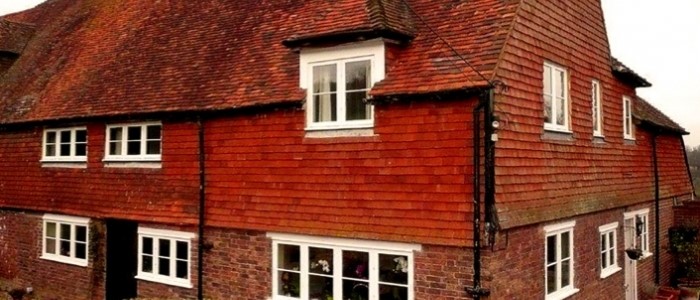Replacing windows in Listed Buildings and Conservation areas

Windows and doors are often the most important visual aspect of a building, particularly if they have survived for generations, showing distinctive mouldings, uneven putty glazing and characterful glass.
Upgrading them is a sensitive task, as there is an inherent conflict between keeping the character of the original and improving levels of thermal efficiency.
In this guide, The Wood Window Alliance share their expert advice with us on how best to replace heritage windows.
- Applying for Listed Building consent
For Listed Buildings, any works (internal or external) to alter, extend or demolish require Listed Building Consent from the Local Authority planning department prior to proceeding. Application forms can be downloaded from the local authority’s website. Guidance is available on the Government’s Planning Portal website.
Local authorities aim to return a decision on smaller schemes within eight weeks; within 13 weeks for major proposals. This includes a statutory 21-day consultation period for consultation with neighbours, amenity societies and other interested parties.
If the application involves a Grade I or Grade II* listed building, demolition, or is particularly complicated, the case will be forwarded to Historic England for expert advice, as will certain categories of work to Grade II listed buildings. Applications in England, Scotland & Wales are made to the local authority. In Northern Ireland they are made to the divisional office of the Planning Service.
- What about Conservation areas?
If a property is not listed, but in a Conservation area, it may still be necessary to obtain planning permission before replacing window and doors. Although houses (but not other buildings, such as flats) are often exempt by being granted ‘Permitted Development rights’, if the property is subject to an ‘Article 4 direction’, prior planning permission from the Council will be required for alterations such as replacing windows and doors, adding conservatories, porches or other extensions.
The local authority will be able to confirm if the property is subject to an Article 4 direction.
Owners of houses where there is no Article 4 direction are allowed to make many alterations without planning permission where that would be out of proportion to the impact of works carried out. The work should be carried out in accordance with current Building Regulations and within the guidelines, ensuring replacement window and doors are of similar appearance to those used in the construction of the house. The homeowner is responsible for compliance.
We recommend holding pre-application discussions with the local authority Planning Officer to check if consent is required and to discuss the proposal. If consent is refused, the owner has six months in which to appeal to the Secretary of State for Communities and Local Government (DCLG) or to submit amended plans based on the written advice provided and re-apply for permission.
Carrying out unauthorized works to a listed building is a criminal offence, and the owner of the building and any individual or company that has undertaken the construction, can be prosecuted. A planning authority can insist all work carried out without consent is reversed at the owner’s cost. An owner will have trouble selling a property with no consent for work undertaken.
Further information on the Building Consent and Permitted Developments can be found on:
http://www.planningportal.gov.uk/uploads/1app/guidance/guidance_note-listed_building_consent.pdf
- Repair or reinstatement
Consent for listed buildings is typically granted on a ‘like for like’ basis, unless the applicant is able to satisfy certain conditions, such as ‘that the building is not of special architectural or historical interest’ – more likely with a Grade II than a higher listing.
For listed buildings of special architectural or historical interest, the planning officer will require the applicant to reinstate and re-use as much of the original material and detail as possible. This may involve scarfing in new sections of timber, freeing sashes, replacing draughtproofing, repairing or replacing hardware, re-glazing (possibly using original glass) and fresh decoration. The original colour may also need to be maintained.
If repair is not possible, the replacement details will need to replicate the existing design details, including mouldings, glazing method and use of historic glass.
- Double-glazed period windows
When the building is not listed, but is in a Conservation Area with an Article 4 direction (i.e. a non-designated heritage asset), then new replacement windows/doors should be installed under Building Regulations that include Approved Document L1B and L2B (AD L).
However, the conservation officer may want to maintain original details (such as single-glazing) that would compromise energy-efficiency in order to preserve character and appearance. AD L allows for this in paragraph 4.19 that states: “Where the replacement windows are unable to meet the requirements of table 1 because of the need to maintain the external appearance of the facade or the character of the building, replacement windows should meet a centre pane U-value of 1.2W/m²K, or single-glazing should be supplemented with low-e secondary glazing….”
Secondary glazing is a poor substitute for an efficient double-glazed window. It can affect the reflection of the windows and the appearance of the interior of the property, as well as presenting condensation and cleaning challenges. Other Heritage advice is to use ‘thick curtains’ etc. that offer little daytime help.
Therefore, it is advisable to meet the Conservation officer prior to a full application to discuss all the options available. The National Planning Policy Framework gives some guidance on these matters. Para 94 advises planning authorities “to adopt proactive strategies to mitigate and adapt to climate change.”
Para 135 states “The effect of an application on the significance of a non-designated heritage asset should be taken into account in determining the application. In weighing applications that affect directly or indirectly non designated heritage assets, a balanced judgement will be required having regard to the scale of any harm or loss and the significance of the heritage asset.”
Planning and Conservation officers have considerable discretion over whether to allow replacement with double-glazed windows, but many are unaware of how well-designed joinery, such as heritage windows from Wood Window Alliance members, can maintain authentic period materials, proportions and detailing, while providing modern levels of thermal, acoustic, security and maintenance performance.
Submitting samples, full drawing details (elevations and plan) with specifications and photographs of previous projects will help with this process, whether for Grade II listed buildings or for those subject to Article 4 directions, as the following studies show.
- Case Study

Grade II Heritage conversion of MoD Officers’ Mess at the Shoebury Garrison.
Having housed Royal Artillery and Gunnery schools since the early 1800’s, Shoebury Garrison is now recognised as an area of national importance and is protected, much of it as a conservation area. Mumford & Wood worked very closely with the developer to ensure their sympathetically designed Conservation™ timber box sash windows and doorsets would meet approval. Made from clear grade engineered timber, these bespoke windows are double-glazed and factoryfinished, providing advanced acoustic and security performance along with a whole window U-value of 1.4 W/m²K, exceeding current Building Regulations.
- Improvements to energy efficiency
A single-glazed window can have a u-value worse than 5 W/m2K. Improvements to the energy performance of single-glazed windows and doors are limited to:
- The simple addition of draught-proofing strips
- Renovation, with bead adjustment and the addition of draught-proofing strips
- Curtains, blinds and shutters (effective only at night)
- Secondary glazing, which, as noted, can affect the reflection of the windows and the appearance of the interior of the property, as well as presenting condensation and cleaning challenges.
Today’s double-glazed timber windows can achieve a BFRC A energy rating or a u-value of 1.4 W/m2K.
- Case study

Hamsell Cottage, Grade II listed.
The owner wanted to improve the appearance and energy-efficiency of this 16th century medieval hall house without compromising its character. Many specific requirements demanded by the Conservation Officer had to be satisfied before conservation and planning permissions were granted.
George Barnsdale supplied traditional timber windows and doors with narrow cavity, krypton filled doubleglazing units. After detailed specifications were provided, discussions between the owner and the Conservation Officer gave the planning team assurance on the suitability of the glazing solution.
The Conservation Officer supported the application on the basis that the slim (6mm gap) glazing system and overall product design replicated the aesthetics of the existing windows and the traditional design expected of a historic property of this style and age, while improving thermal efficiency.
- Glazing options
Crown glass 14th to mid-19th century
Molten glass is gathered on the end of a blowpipe and a ‘balloon’ shape blown. The blowpipe is removed and a rod attached. The glass is spun until a disc is formed. The outer glass is cut into small panes and the central section of the spun glass becomes the bull’s eye or bullion.
Crown glass can be identified by its concentric ripples and air bubbles.
Cylinder glass 19th century
This is formed by blowing molten glass into elongated balloon shapes whilst swinging the cylinder in a trench to stretch it. The ends of the cylinder are cut off and the glass allowed to cool before cutting down its length. The glass is re-heated in an oven, annealed, and the cylinder unfolded into a flat sheet. Cylinder glass displays a distinctive character of faint parallel ripples.
For the repair and reinstatement of windows in listed buildings of special architectural or historic interest, the glass should, ideally, be preserved and reused. New float glass may not be acceptable due to its uniform, flat, reflective surface.
Alternatives
It is possible to imitate historic crown and cylinder glass using hand or machine drawn glass. These types of glass are often used as the outer layer in a doubleglazed unit to add character and reduce visibility of the inner layer.
However, depending on how close the replacement needs to be to the original, a less expensive 3mm ‘period style’, or horticultural, glass may be acceptable. This has a wavy reflection without having the same quality as hand blown glass.
- Narrow cavity double-glazing
Narrow cavity insulated glazing units are sometimes used as a compromise between energy-efficiency and authenticity. They incorporate a cavity of 8mm or less and feature reduced spacer-bar sightlines.
Where possible, it is preferable to use standard cavity IGUs, which are better value, have a longer life and are more energy-efficient. However, where they are required, it is important to check they have the correct test evidence and guarantees in place to ensure they are not subject to early loss of performance or failure.
Care needs to be taken when specifying large units with a 4mm cavity, otherwise the two sheets of glass could touch in the centre under load.
It is imperative the correct glazing method, as recommended by the manufacturer, is followed. Linseed oil putty should be avoided as it can lead to the premature breakdown of the unit; use putty substitutes, such as Dry Seal MP and Kawo Elastokitt.
- Standard double-glazed units
24mm double-glazed units may be used in windows and doors in Conservation areas not subject to Article 4 directions. They are more energy-efficient and have a longer service life than narrow cavity units. Ideally units should be factory-fitted, drained and vented to fully coated frames. All units should be CE marked.
Authentic period sightlines and glazing bars as slim as 16mm are possible by using a non-structural applied glazing bar, which is matched with an internal spacer bar to give the appearance of individual panes.
Factory-finished double-glazed windows are low maintenance, with modern energy, acoustic and security performance and a 60-year planned service life.
- Typical glazing bar details
12: Useful information
Historic England
https://historicengland.org.uk/advice/
Historic Environment Scotland
https://www.historicenvironment.scot/advice-andsupport/
Historic Environment Wales (Cadw)
http://cadw.gov.wales/historicenvironment/policy/historicenvironmentbill/?lang=en
Historic Buildings & Monuments, Northern Ireland
https://www.nidirect.gov.uk/articles/historic-buildingsand-monuments
Northern Ireland Planning Portal
Institute of Historic Buildings
National Training Heritage Group
WWA Replacing Windows in Conservation Areas
Building Conservation.com


